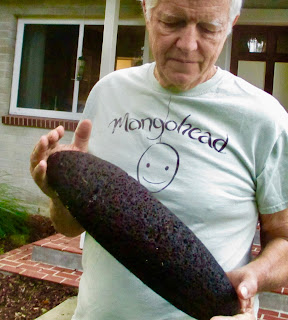Imagine climbing into a six-foot sphere -already crowded with two others- then slowly sinking 12,000 feet into a black, frigid ocean. Does this sound like your idea of fun? That's what our friend, Mike Perfit, does for a living. He’s gone down over forty times in a small submarine to study underwater volcanoes.
Here you see how "three guys inside a ball" fits into the rest of the sub's non-pressurized framework.
We invited Dr. Mike, a UF Professor, to share his adventures (without sharing Covid) at a neighborhood gathering. We kept it small with everyone distanced in our front yard.
That’s what our parties looks like in this era of Trumpus Pandemicus. Now we tap minds instead of kegs.

His stories took us on his deep water studies aboard the submersible, Alvin. The pilot has the best seat in front of two scientists like Mike.
Mike riding shotgun behind the sub's pilot
After the sub cuts loose from the mothership it sinks three hours to rub noses with NW Pacific volcanoes. For the next three hours they explore, record data, and photograph mysteries of the deep. There’s a whole world down there living off the thermal energy pushed up from the earth’s molten core. You might see sharks, sea worms, or even a tripod fish.
A Tripod Fish has fins so long it can stand on the ocean floor. No eyes are necessary in its light-less world.
Almost everything far below is black, white, or shades of grey. “Occasionally you’ll see a speck of green in the distance. Moving closer you’ll probably discover a Heineken bottle, said Mike adding, “something red would probably be a Coke can”.
Someone asked it the ocean floor looked like a garbage dump and Dr. Perfit pointed out that most or our eternal discards are floating plastic. Sadly he noted that our oceans have vast floating “islands”, as big as countries, consisting of this oil-based trash. Think about that before your buy your next six-pack of water.
The pressure is incredible so far below, two tons per square inch, like an elephant sitting on your finger. For fun, the Alvin’s scientists write messages on styrofoam coffee cups then attach them, caged, to the sub’s exterior. By the time returns to the surface they have shrunken to the size of a thimble. 
Farting is discouraged. The university’s distinguished geology professor told us, “You try to be mindful of what you eat the day before”. Of course we wanted to know how you take a leak inside the titanium ball.
The three aboard are entertained by music played on the captain’s CD player. It’s important as most of the dive consists of traveling rising or sinking in the dark. On one dive the sub’s pilot forget his discs. Fortunately, there was one still in the player so for eight hours, the crew listened to probably the most appropriate album, the Beatles “Magical Mystery Tour”.  By the end of the talk we all felt fortunate to have briefly busted out of our houses for Mike’s underwater tour, and, to learn that Alvin was much more than a chipmunk.
By the end of the talk we all felt fortunate to have briefly busted out of our houses for Mike’s underwater tour, and, to learn that Alvin was much more than a chipmunk.
_______________________________________
_______________________________________
As folks were leaving I showed Mike this rock I found in the surf on Maui. He quickly pointed out that it was a “volcano bomb”, created when liquid basalt rock shot up to solidify in an aerodynamic shape. He added, “That would might hurt if it came down on your head.”


